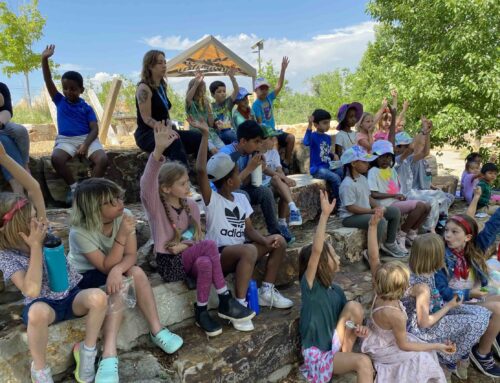
Can you use your words to let them know how you are feeling?
Can you use your words to solve this problem?
Can you use your words?
When children are learning to become more sophisticated speakers and thinkers, they often find themselves frustrated with tasks or persons or feelings for inexplicable reasons. We have all seen what comes next; developmentally appropriate pushing or hitting or physical destruction may arise from these moments. Perhaps they are reacting to being hungry or feeling left out or just so excited about sharing that they want to (or need to) touch someone or something.
Children long for physical contact with the people and the world around them. Sometimes as exploration and sometimes as reaction, for better or worse, children are in touch with the environment around us. They remind us of a tactile and kinesthetic world that we forget when we spend days lost in our own thoughts, locked into our own heads. They challenge us to join them in play and conversation when we are lost in worry or everyday tasks.
With the mandated distancing of people and objects around us today, humans regardless of age are being relegated to an internal understanding of the world. This relegation feels like an opportunity for a doubly distanced reality for children — we need to make sure that it isn’t.
We as caregivers and trusted adults must find ways to support children in both their search for words and their pursuit of touch. It is essential to their development and our own. I believe this is possible because I believe that good teaching as well as parenting comes through action — we all learn by observation. We also all need things that we can actually do in our everyday lives for a sense of security and a sense of control.
What do we want children to observe us doing in this moment? How do we want children to see us navigating this ever-changing landscape? I think it starts by modeling two fundamental and incredibly powerful pieces of the human experience: speech and touch.
When children hopefully return to school in a few weeks, they will be bringing small masks with them. They will be greeted by adults who are trying to beam big, welcoming smiles through face coverings. With half of the face obscured, we will need to teach children to rely on reading cues from eyes and foreheads and most importantly, voices. While a quick glance of approval or concern could initiate a nonverbal conversation between teacher and student in the past, we will have to rely on more clear and consistent verbal communication in its stead.
We will be working with our teachers during their professional development this summer to help them express emotions and ideas more effectively through their voices. This newly bolstered vocal relationship will help our students (and teachers) to hear and understand and model emotions through the voice. Coaching children to be more verbally expressive is already an important component of our curriculum, now its impact outside the classroom will be even more apparent.
Simultaneously, we will be working with our teachers to develop healthy tactile learning experiences. Working with provocative objects individually and in pairs will replace large groups of students touching the same things. Children sitting independently instead of on laps or snuggled together will become a healthy way of exploring independence. Our teachers will be developing ways for children to still maintain as much physical exploration as possible while remaining safe. In light of this, we hope that parents will find as many ways to remind children of their bodies and their embodiment as possible at home. Hugs, snuggles, wild play, dancing, and holding hands are just a few examples. Make the extra effort to support your child as they are learning and growing with all of their senses. Home is a less inhibited environment for this development, we hope you will exploit that opportunity.
I truly hope that this blog will be of little use in a year. But for the time ahead, we will be working with new restrictions and constructs of time in school and time with other people. I do believe that restrictions can ignite creativity — having a limited set of tools can be freeing. It is with that mindset of growth and hope that I challenge myself, our teachers, and you to help the children we all care about develop sophisticated understandings of themselves and the world around them through speech and touch.







